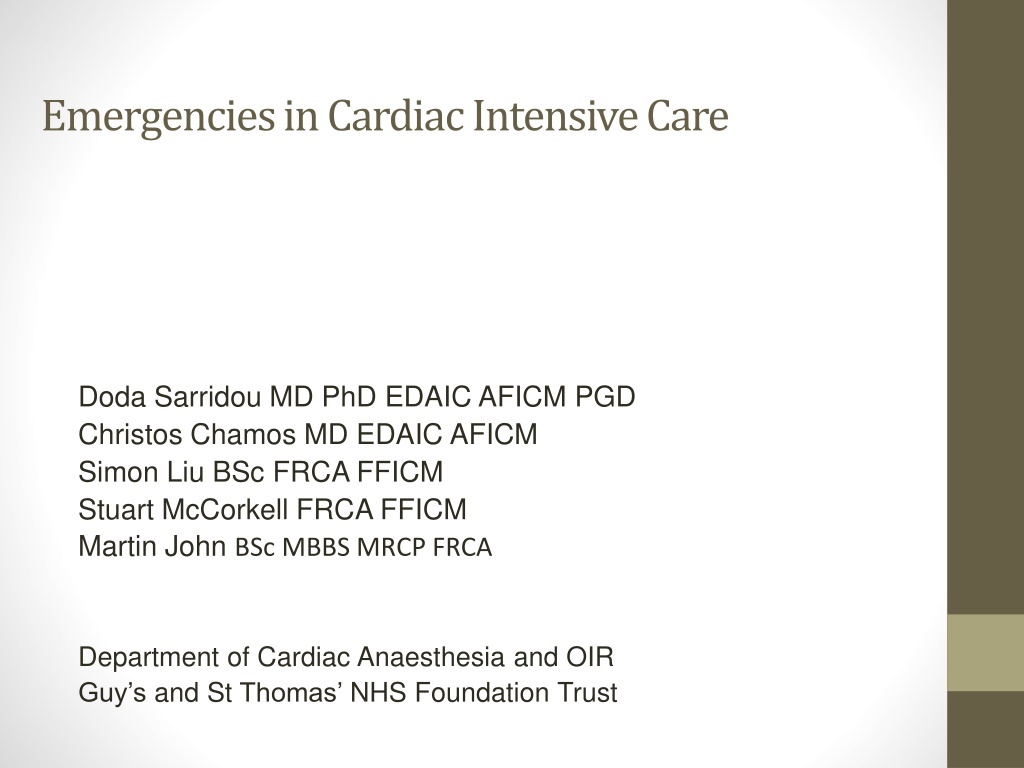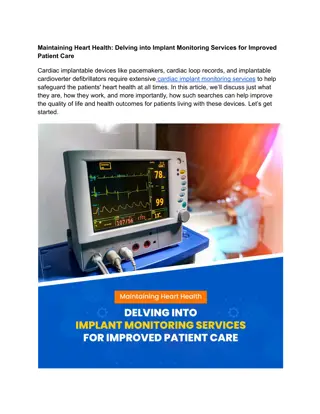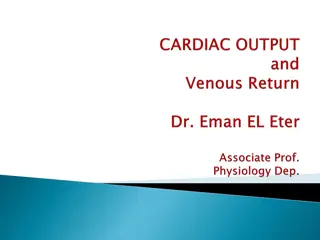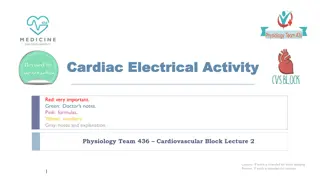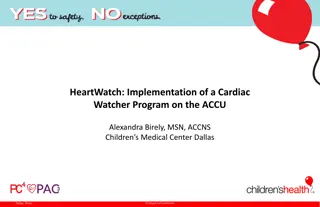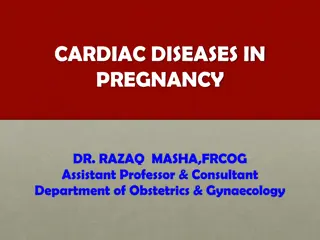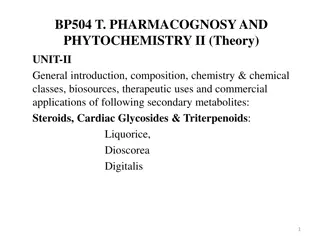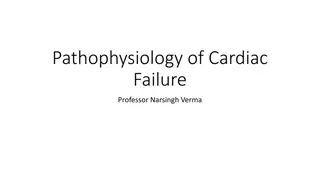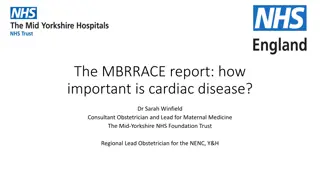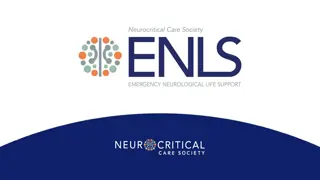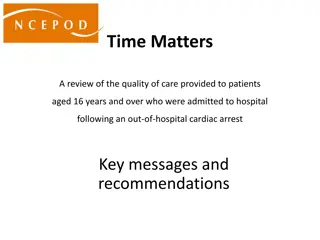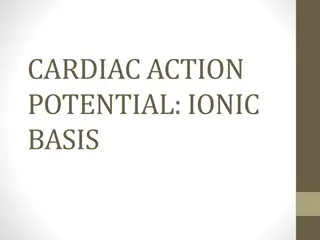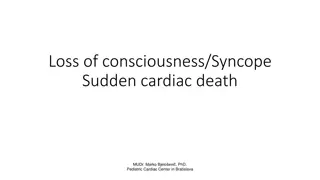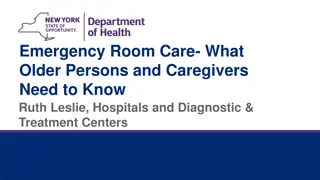Emergency Management in Cardiac Intensive Care
Information on managing emergencies in cardiac intensive care including topics like hemorrhage post-cardiac surgery, tamponade post-cardiac surgery, and control of bleeding. Details on initial steps for bleeding control, teamwork in managing hemorrhage, and diagnosing tamponade post-cardiac surgery are provided.
Download Presentation

Please find below an Image/Link to download the presentation.
The content on the website is provided AS IS for your information and personal use only. It may not be sold, licensed, or shared on other websites without obtaining consent from the author.If you encounter any issues during the download, it is possible that the publisher has removed the file from their server.
You are allowed to download the files provided on this website for personal or commercial use, subject to the condition that they are used lawfully. All files are the property of their respective owners.
The content on the website is provided AS IS for your information and personal use only. It may not be sold, licensed, or shared on other websites without obtaining consent from the author.
E N D
Presentation Transcript
Emergencies in Cardiac Intensive Care Doda Sarridou MD PhD EDAIC AFICM PGD Christos Chamos MD EDAIC AFICM Simon Liu BSc FRCA FFICM Stuart McCorkell FRCA FFICM Martin John BSc MBBS MRCP FRCA Department of Cardiac Anaesthesia and OIR Guy s and St Thomas NHS Foundation Trust
Hot topics in OIR Haemorrhage post Cardiac Surgery Tamponade post Cardiac Surgery Management of inotropes and vasopressors Temporary Pacing CALS protocol
Bleeding First steps Control systolic pressures target 90-120mmHg depending on co- morbidities e.g. cerebro- vascular disease. Use GTN (1stline) /Labetalol (2ndline) infusion to control BP Target Hb >85g/L Keep patients sedated and ventilated to avoid straining and in case of surgical re-exploration Avoid excessive IV fluids (colloid, crystalloid) when correcting hypovolaemia - they can create or worsen dilutional coagulopathy. Use blood products when available to treat active bleeding. Consider placing patients in Trendelenburg position and starting low dose noradrenaline infusion as required until blood products are available. Check cross matched PRBC are available in the theatre fridge/blood bank, ensure you have 4. Investigations and treatment Send ICU profile bloods ASAP and repeat regularly (FBC, coagulation studies, U+Es) Target fibrinogen > 2.0 using cryoprecipitate 2 pools for adults Normalise INR and APTTr using FFP.) Correct residual Heparin effect (Check ACT or compare APTTr vs INR -Protamine 25-50mg IV) Give tranexamic acid 2g IV Give Platelets if patient has received recent antiplatelet therapy Coagulopathy - the fatal triad of hypothermia, hypocalcaemia and acidosis Actively rewarm monitor temperature and aim for normothermia Bair hugger IV fluid warmer vital for PRBC stored at 4 Check Calcium (either via U+Es or ABGs). Titrate Calcium Chloride 10% IV 3-5mg boluses slow push Correct any respiratory component of acidosis
HaemorrhagePart I Teamwork Surgical/ Blood bank / Haematology Inform surgical team (0200) and consultant covering OIR Significant bleeding may need surgical re-exploration As a guide blood loss of >3ml/kg 1st hour, >2ml/kg 2nd hr, >1ml/kg any subsequent hr is excessive Initiate Code Red if catastrophic bleeding call 2222 announce Code Red and location. Switch will have the lab call back immediately and send a porter to lab to collect blood/products ASAP Useful numbers (Blood bank 84774 Bleep 0201 Haematology Reg 0122 in hours, via switch out of hours)
Tamponadepost Cardiac Surgery Diagnosis: It is ultimately clinical and needs a high index of suspicion! You must think of it as a differential in a deteriorating cardiac surgical patient in order to diagnose it Is based on: signs of low cardiac output: hypotension/ escalating doses of vasopressors/ oliguria/ poor peripheral perfusion/ rising lactate AND echocardiographic evidence of pericardial fluid or clots +/- echo signs of tamponade (cardiac chamber collapse/ variation in blood flow through cardiac valves) Remember TTE gives poor views postop and cannot exclude a posterior pericardial effusion Beck s triad (high central venous pressure (CVP) or distended neck veins/ hypotension/ reduced cardiac sounds) is not always present. Hypovolaemia, beta blockade, pacing, noisy environment can mask diagnostic signs. Similar to other subtle signs (electrical alterans - ECG/pulsus paradoxus) Typically chest drainage will be reduced or absent (often following increased drain output) First presentation can be arrhythmia or cardiac arrest. For hypotension and rising inotrope requirement: Main differential diagnosis post cardiac surgery is ventricular dysfunction. Echocardiography will distinguish between the two conditions.
TamponadePost Cardiac Surgery Urgent surgical re-exploration. Pericardiocentesis in almost never an option in cardiac surgical patients Usually performed in East wing cardiac theatres. But may have to take place in OIR / ITU in the case of an extremely unstable patient. Immediately inform: cardiac surgical registrar (bleep 0200) and consultant cardiac anaesthetist Out of hours you may have to transfer patient to theatres until senior anaesthetist arrives. In the meantime: Try to maintain normal haemodynamics and CO: fluid and/ or blood administration, vasopressors and/or inotropes. The patient will need high systemic vascular resistance, high normal heart rate, preservation of sinus rhythm if possible. Keep patient sedated + paralysed in view of re-exploration Correct any coagulopathy/ order appropriate blood products
Inotropes and Vasopressors -Commonly used agents on OIR Noradrenaline ( 0.01-0.20 mcg/kg/min) Dobutamine ( 1-10 mcg/kg/min) Milrinone ( 0.01-0.3 mcg/kg/min) Hypotension will be manifested with acute drop on the BP, tachycardia +/-, rise of the CVP and is associated with high requirements of vasopressors and inotropes. -Causes of Hypotension: - Hypovolaemia, (surgical Bleeding output > 400mls/h, or > 200 mls first 2-3 hours. Coagulopathy ( Needs PLT, FFP, Cryo) tamponade ( presence of blood or clots in the pericardium, normally low drain ouput, CVP>20) pump failure ( acute or acute on chronic LV/RV failure) inflammatory response to surgery (long CPB time) -Correct hypothermia, consider Heparin rebound effect repeat ACT -Management out of hours acute deterioration Always inform the consultant on call Communicate the concern with the rest of the team , Nurse in charge , other SPRs Do not escalate NAD more than 0.2 mcg/kg/min - Initiate CO monitoring , ( PICCO, LIDCO, Normal CO >4-5, CI> 2). CV gas> 70% Inform 0200 usually- experienced trainees and senior fellows Consider TOE ( OIR cons) or TTE, call 0100 cardiology SPR
Temporary Pacing What s the first rule? You need to differentiate the heart s response to pacing from the ECG appearance. The arterial line or oximetry trace will show you when the heart is contracting, the ECG will show you pacing spikes. Why do cardiac patients need temporary pacemakers? >3% of cardiac patients require pacing in postoperative period most commonly for AV block, bradycardia or to improve cardiac output with sequential AV pacing. Pre-existing conduction defect, Diabetes, valve surgery, high cardioplegia volumes and pacing required to separate from bypass are the major predictors of pacing requirement postoperatively. Epicardial pacing wires reduce risk from low CO state or heart block but bring new risks of infection, myocardial damage, perforation and TAMPONADE - especially on removal. Risk/benefit ratios vary between patients so there is no universally accepted practice. At GSTT the majority of patients who receive cardioplegia have RV wires implanted, some may have RA wires in addition. LA and LV wires are rare.
Temporary Pacing How do we check a pacemaker s function? Initial check is done in theatre on setting up pacing and thresholds should be confirmed in handover. It is checked once daily by the nursing staff during the day shift when immediate expert help is present. You are not expected to do this but must understand the process. DO NOT interrupt pacing if patient is dependent on it seek consultant advice. Check UNDERLYING RHYTHM turn rate down until patient s rhythm is exposed, record native ECG. See below for rate setting. Check SENSITIVITY the minimum voltage the pacemaker can sense. If patient has no underlying rhythm to detect, set sensing voltage to 2mV. If patient has an underlying rhythm: Turn pacing rate below patient s native rate. Increase voltage setting (less sensitive) until sensing light stops flashing with each native QRS complex. Pacing spikes will appear on ECG. Reduce voltage setting (more sensitive) until sensing light flashes with each native QRS, this is the pacing threshold. Set to half this threshold. Check CAPTURE the minimum output that will stimulate an action potential in the patient s heart. DO NOT CHECK capture threshold if there is no underlying rhythm you may not regain capture once lost. Set pacing rate above native rate, minimum 80. Confirm every pacing spike is followed by a QRS. If not, you are already below capture threshold. Reduce pacing voltage until capture is lost. Increase voltage until capture is regained - this is the capture threshold. Set voltage to 2V above capture threshold and confirm reliable capture is restored.
Troubleshooting Failure to pace Heart rate is lower than rate set on pacemaker and there are no pacing spikes on ECG. Causes 1. Battery in pacemaker has failed 2. Lead or connector malfunction 3. Sensitivity voltage set too low pacemaker is inhibited by electrical interference (patient movement, equipment) 4. Pacemaker inhibited by ectopic activity with too small a voltage to show on surface ECG 5. Cross-talk inhibition (dual chamber systems only) Resolution Check battery indicator on pacemaker and change pacemaker if failed Switch temporarily to fixed rate mode (V00, D00). If there are still no visible pacing spikes, 3-5 are eliminated as cause. If indicated above, check connections (wear gloves), change connector lead, change pacemaker. INFORM CONSULTANT
Temporary Pacing Failure to capture There are pacing spikes on ECG but no mechanical association the arterial or oximetry waveform does not correspond with the pacing rate. Causes Increased resistance at electrode tip, usually inflammatory fibrosis Hyperkalaemia, profound acidosis Drugs e.g. Beta blockers, sodium channel blockers, calcium channel blockers Resolution Increase output voltage until capture returns Swap connector around to reverse polarity (wear gloves) Correct metabolic and drug causes Put backup method of pacing in place ASAP as the wire is likely to fail in time external pacing via defibrillator or transvenous pacing via cardiology registrar INFORM CONSULTANT- External Pacing via Defibrilator
CALS Algorithm CALS approach Most cardiac patients in OIR will have full invasive and capnography monitoring. -Arrest is confirmed by a flat arterial line trace, central venous pressure and pulse oximetry, as well as a reduced capnography trace. No need to reassess for 10 seconds and the first responder should immediately initiate the arrest protocol (attached to arrest trolley), inform the cardiothoracic surgeons (bleep 0200) and call for the resternotomy trolley.
The priority is to immediately manage the arresting rhythm and open the chest (within 5 mins). Managing the arresting rhythm i) VF /VT External chest compressions can be delayed for no more than 1 minute to allow for expeditious defibrillation. Deliver 3 sequential defibrillation attempts at 150J. If unsuccessful, immediate chest opening is advised. External cardiac compression should also be commenced (compression depth target = 60 mmHg on art line trace at a rate of 100 bpm). Amiodarone 300mg (bolus) should be administered via the central line and one further defibrillation attempt at 150J should be made every 2 mins until the chest is opened. ii) Asystole/severe bradycardia Disruption of intrinsic cardiac conduction is common post operatively and patients may have single chamber (ventricular), dual chamber (atrial and ventricular) or no pacemaker system attached. External cardiac compressions can be delayed for no more than 1 minute to allow for establishing pacing. Single chamber systems: Ensure the pacing wires are connected to a functioning pacing box. Set stimulation thresholds to maximum (15V, full anticlockwise turn). Set pacing rate to 80-100 bpm. Asynchronous pacing is appropriate (Set sensing dial at asynch, full clockwise turn). Look for pacing spike capture on ecg. Dual chamber systems: Ensure the pacing wires are connected to a functioning pacing box. Set stimulation thresholds (Both Atrial [A] and Ventricular [V]) to maximum. Set rate at 80-100 bpm. Set pacing mode to DDD. (Alternatively, some boxes have an emergency button which activates appropriate asynchronous pacing which can be pressed). Look for pacing spike capture on ecg.
No pacing system: Start external cardiac massage whilst setting up for attempted external cardiac pacing (maximum threshold at a rate of 80- 100 bpm). If external pacing fails, the chest needs reopening. iii) Pulseless electrical activity This rhythm is non shockable and not amenable to pacing so external cardiac compressions as well as plans for resternotomy should be commenced immediately. Note; If a paced patient develops PEA, then the pacemaker should first be turned off to rule out underlying VF. Airway management Increase Fio2 to 100% and confirm ET position + cuff inflation. Listen for breath sounds to exclude pneumo/haemothorax. Drugs Following arrest, stop all infusions (many cause vasodilatation). If awareness is a concern, sedative infusions can be continued at the discretion of the senior clinician. Adrenaline (particularly at conventional arrest doses) can precipitate catastrophic harm so do not give unless a senior doctor advises this. Atropine for asystole or extreme bradycardia is not recommended.
Summary All the above conditions are life threatening and require immediate senior response and input INFORM CONSULTANT ON CALL Correct Coagulopathy if any Correct hypovolaemia Call 0200 Cardiac Surgery SPR/Fellow Call 0100 Cardiology SPR Consider TTE or TOE
